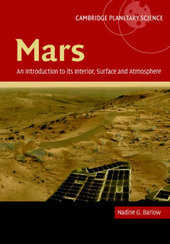
|
Mars: An Introduction to its Interior, Surface and Atmosphere
Hardback
Main Details
| Title |
Mars: An Introduction to its Interior, Surface and Atmosphere
|
| Authors and Contributors |
By (author) Nadine Barlow
|
| Series | Cambridge Planetary Science |
|---|
| Physical Properties |
| Format:Hardback | | Pages:276 | | Dimensions(mm): Height 254,Width 178 |
|
| Category/Genre | Solar system |
|---|
| ISBN/Barcode |
9780521852265
|
| Classifications | Dewey:523.43 |
|---|
| Audience | | Professional & Vocational | |
|---|
|
Publishing Details |
| Publisher |
Cambridge University Press
|
| Imprint |
Cambridge University Press
|
| Publication Date |
10 January 2008 |
| Publication Country |
United Kingdom
|
Description
Our knowledge of Mars has changed dramatically in the past 40 years due to the wealth of information provided by Earth-based and orbiting telescopes, and spacecraft investigations. Recent observations suggest that water has played a major role in the climatic and geologic history of the planet. This textbook covers our understanding of the planet's formation, geology, atmosphere, interior, surface properties, and potential for life. This interdisciplinary textbook encompasses the fields of geology, chemistry, atmospheric sciences, geophysics, and astronomy. Each chapter introduces the necessary background information to help the non-specialist understand the topics explored. It includes results from missions through 2006, including the latest insights from Mars Express and the Mars Exploration Rovers. Containing the most up-to-date information on Mars, this textbook is essential reading for graduate courses, and an important reference for researchers.
Author Biography
Nadine Barlow is Associate Professor in the Department of Physics and Astronomy at Northern Arizona University. Her research focuses on Martian impact craters and what they can tell us about the distribution of subsurface water and ice reservoirs.
Reviews'... as an introduction to the various scientific disciplines as they relate to Mars research, it should prove useful to students and other interested readers with a science background.' Mark Williamson, www.satellite-evolution.com
|